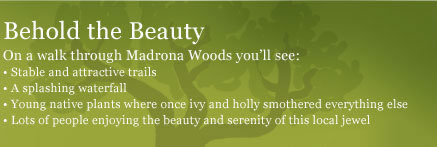Some Philosophizing
We’ve heard from a couple of people who were disturbed by recent activities in Madrona Woods involving maintenance of trails—raking leaves off the trails in the autumn and adding thick, compacted gravel on one trail in February. But we believe both incidents point to a larger issue—the overall look and feel of the woods.
Many of us who have been working to restore this park to a more natural and sustainable place also cherished the woods for the somewhat mysterious getaway it provided for kids and adults before 1996. We started out with the simple goal of getting rid of the ivy climbing trees and choking out growth in the understory.
Part of the early process involved education of those who chose to contribute to the effort and others in the community. Through a series of walks led by experts in several environmental fields, we learned that if we didn’t undertake more serious restoration, we would probably end up with a virtual ivy/holly/laurel desert in 50 years. So we got grants and developed plans. Before we could proceed with the more ambitious of the plans, we had to involve the Seattle Department of Parks and Recreation, the manager of the park. They approved our plans in 2000, and we agreed to follow their procedures and guidelines.
We’ve made great progress on all of our objectives, but there’s no question that the nature of the woods has changed. Where the ivy, laurel, holly, and blackberries once provided a lush, green, and private look, now there are open cleared areas covered by brown mulch with relatively small trees and shrubs slowly growing in. The trails have been widened and stabilized according to Parks Department standards. The new trail leading down to Lake Washington Boulevard, with all its steps, is far from primitive, and plants are slowly growing in along it. Daylighting the stream has meant rearrangement of the ravine along the north edge of the woods and the lawn area of Madrona Park.
We have gotten mostly positive feedback for these projects, but we know there are people who liked the old way better. We’re sorry not everyone can be pleased, but those with the commitment and energy to put into it have obviously done things the ways that seemed best to them.
Remember, the small plants will grow in over time, bringing more green and lushness back to the spaces that now seem open and too tended. This will also bring more diversity for wildlife. We’re committed to keeping the trails safe and comfortable for most people to use. This means raking leaves off of them in the fall so they don’t decompose and speed the break-down of the surface. And it means in especially mud-and-slide-prone areas, using the Parks Department’s thick, packed gravel for stability and longevity. It too will weather and look less stark over time.
Though much of the restoration is far enough along that we can’t change it, there are many details decided day by day. Don’t hesitate to let us know if you have ideas that would make Madrona Woods more like what you want it to be. In the meantime, try to imagine what it will become.

